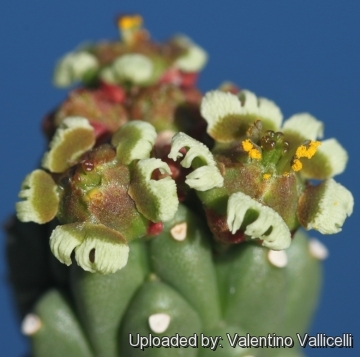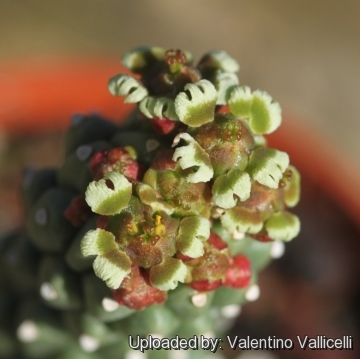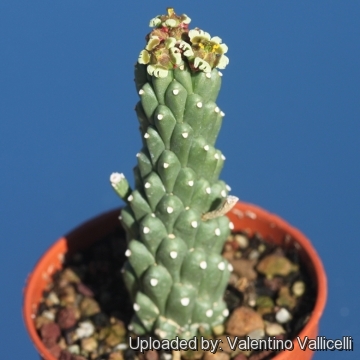
Euphorbia caput-medusae Photo by: Xero Sicyos
Origin and Habitat: Cape region of South Africa, from Namaqualand to Mossel Bay.
Habitat: It grows on sandy flats among the grass and on rocky coastal outcrops. It is particularly common in the Peninsula Shale Renosterveld vegetation of Signal Hill.
Synonyms:
See all synonyms of Euphorbia caput-medusae
Common Names include:
ENGLISH: Medusa's Head
RUSSIAN (Русский): Молочай голова медузы
SPANISH (Español): Cabeza de Medusa
Description: Euphorbia caput-medusaeSN|23413]]SN|23413]] is a sprawling, succulent shrub that resembles the head of Medusa, with a rosette of narrow, serpent-like stems arising from a short, central caudex. The whole plant sometimes exceed 1 metre in diameter, but more frequently is about 40-70 cm wide. Look down into a large specimen, you'll see what looks like a sun flower; it's another example of a Fibonacci spiral. Euphorbia caput-medusaeSN|23416]]SN|23413]] was introduced in Europe around 1700 and was one of the early plants described by Linnaeus. The whole plant produce a caustic milky sap.
Main stem (rootstock): Partly buried in the ground, globe-shaped merging with the fleshy tap root, up to 20 cm in diameter. From the central tuberculate growing point, the rootstock produces numerous crowded branches, which look like a bunch of octopus tentacles and twist over each other to form a rather lumpy hemispheric cushion.
Branches: Cylindrical or somewhat cylindric-clavate, subleafless and spineless but knobbly, uniformly green, each erect 5-10 cm long at the central part, ascending-spreading or decumbent at the circumference, 18-75 cm long and 10-30 mm in diameter, obscuring the centre, tessellated with prominent obliquely elongated tubercles to 8 x 5 mm broad;
Leaves: Linear, acute or obtuse, up to 5 mm, thick and fleshy, flat or slightly concave-channelled above, very convex or obtusely keeled beneath; rapidly deciduous.
Flowers: Cyathia solitary ( specialised inflorescences), clustered at the end of the branches in the axils of the tubercles; peduncles 1-10 mm long, with 5-7 small bracts, hardening and persisting to form a cup-shaped involucre around or beneath the inflorescence, with five incurved (bent inwards) lobes ; Cyathia approximatively 12 mm in diameter; nectar glands 4 x 6 mm broad, shining green, margin divided into 3-6 white linear entire or toothed processes which form a fringe around the individual male flowers, each of which has a single stamen, and the single female flower with an elongated pedicel (flower stalk); ovary obtusely lobed, sessile.
Remarks: When grown from seed, a large globose caudex partly buried in the ground is developed, from which the numerous branches arise, as in all other species of this group. But if you take a cutting from this plant (and one or two other euphorbias of similar extraordinary form), the globose caudex is not formed, you will get a strange sideways 'finger' that will not come true to the shape of the parent, it becomes a cylindric or clavate stem rising some centimetres or even up to 60 cm above the ground and produces a bunsh of branches at the top. It is upon branches rooted in this manner that Euphorbia commeliniiSN|23413]]SN|23416]], DC., and Euphorbia caput-medusaeSN|23413]]SN|23413]] var. major Aiton, were founded and supposed to represent distinct species, the habit being different.
Subspecies, varieties, forms and cultivars of plants belonging to the Euphorbia caput-medusae group
Bibliography: Major references and further lectures
1) Diana Morgan “Succulents for Mediterranean Climate Gardens” Rosenberg Publishing Pty, 01/Sep/2004
2) Urs Eggli “Illustrated Handbook of Succulent Plants: Dicotyledons” Volume 2. Springer, 2002
3) Goldblatt, P. & Manning, J. “Cape Plants. A Conspectus of the Cape Flora of South Africa.” National Botanical Institute, Cape Town & Missouri Botanical Garden, St Louis. (2000)
4) Manning, J. & Goldblatt, P. “West Coast: South African Wildflower Guide” 7. Botanical Society of South Africa with the Darling Wildflower Society, Cape Town.1996.
5) Prain, D. “Euphorbia caput-medusae” L. Curtis’s Botanical Magazine t. 8673 (1916).
6) Raimondo, D. et al. “Red List of South African Plants” Strelitzia 25. South African National Biodiversity Institute, Pretoria. 2009.
7) Matilda Smith “Hand-coloured lithograph of Euphorbia caput-medusae” in Curtis’s Botanical Magazine 1916
8) By N. E. Brown, J. Hutchinson and D. Prain. “Flora Capensis” Vol 5 Part 2, page 216 (1925)
 Euphorbia caput-medusae Photo by: Valentino Vallicelli
Euphorbia caput-medusae Photo by: Valentino Vallicelli Euphorbia caput-medusae Photo by: Valentino Vallicelli
Euphorbia caput-medusae Photo by: Valentino Vallicelli Euphorbia caput-medusae Photo by: Valentino Vallicelli
Euphorbia caput-medusae Photo by: Valentino VallicelliSend a photo of this plant.The gallery now contains thousands of pictures, however it is possible to do even more. We are, of course, seeking photos of species not yet shown in the gallery but not only that, we are also looking for better pictures than those already present.
Read More... Cultivation and Propagation: Euphorbia caput-medusaeSN|23413]]SN|23413]]is cultivated as an ornamental, and is a particular favourite of succulent plant enthusiasts. It is an easy species to grow that is suited for any well drained soil in full sun.
Growing rate: It is a relatively slow growing and long lived plant and once established, it will be content in its position and with its soil for years.
Soil: Give the plant an airy growing medium which mainly consists of non organic material such us clay, pumice, lava grit, and only a little peat or leaf-mould.
Fertilization: Need a perfect fertilizer diet in summer. Use preferably a cacti and succulents fertilizer with high potassium content including all micro nutrients and trace elements or slow release fertilizer.
Exposure: It can tolerate moderate shade, and a plant that has been growing in shade should be slowly hardened off before placing it in full sun as the plant will be severely scorched if moved too suddenly from shade into sun.
Watering: Water regularly during the active growing season. No water should ever be allowed to stand around the roots. Keep almost completely dry in winter. However this spurge will tolerate dryness and can even thrives in poor, dry soils, but do better when grown in nutrient-rich soils with regular watering.
Aerosol salt tolerance: It is salt tolerant.
Hardiness: Some cold tolerance. This spurge has tolerated temperatures down to –6ºC and even a little snow. However it can be difficult to get it to look its best without a good amount of heat and sun and so it is only really suited to the tropics (USDA Zones 9-12)
Rot: Rot it is only a minor problem with Euphorbias if the plants are watered and “aired” correctly. If they are not, fungicides won't help all that much.
Known hazards: As with all other Euphorbias when a plant get damaged it exudes a thick white milky sap known as latex. This latex is poisonous, and may irritate skin. Pay extreme attention not to get any in your eyes or mouth. Cultivated plants must be handled carefully.
Propagation: The plant can be reproduced by seeds or cuttings If you take a cutting from this plant, you will get a strange bunch of sideways 'fingers' that will not come true to the shape of the parent. In this case, wait for seed. If you remove an offset, remember to let it dry for some days, letting the wound heal (cuttings planted too soon easily rot before they can grow roots). Lay it on the soil and insert the stem end partially into the substrate. Try to keep the cutting somewhat upright so that the roots are able to grow downward. It is better to wash the cut to remove the latex.













